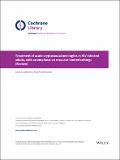Files in this item
Treatment of acute cryptococcal meningitis in HIV infected adults, with an emphasis on resource-limited settings
Item metadata
| dc.contributor.author | Sloan, Derek | |
| dc.contributor.author | Dlamini, Sipho | |
| dc.contributor.author | Paul, Navin | |
| dc.contributor.author | Dedicoat, Martin | |
| dc.date.accessioned | 2018-03-28T09:30:14Z | |
| dc.date.available | 2018-03-28T09:30:14Z | |
| dc.date.issued | 2008-10-08 | |
| dc.identifier | 241962719 | |
| dc.identifier | 6c8fa694-31eb-40fb-8f1b-c9f0b0b4217a | |
| dc.identifier | 18843697 | |
| dc.identifier | 55149089108 | |
| dc.identifier.citation | Sloan , D , Dlamini , S , Paul , N & Dedicoat , M 2008 , ' Treatment of acute cryptococcal meningitis in HIV infected adults, with an emphasis on resource-limited settings ' , Cochrane Database of Systematic Reviews , no. 4 , CD005647 . https://doi.org/10.1002/14651858.CD005647.pub2 | en |
| dc.identifier.issn | 1469-493X | |
| dc.identifier.uri | https://hdl.handle.net/10023/13039 | |
| dc.description.abstract | BACKGROUND: Despite the advent and increasingly wide availability of antiretroviral therapy, cryptococcal meningitis (CM) remains a significant cause of mortality and morbidity amongst individuals with HIV infection in resource-limited settings. The ideal management of CM remains unclear. The aim of this review is to assess the evidence for deciding on which antifungal regimen to use as well as other modalities of management to utilise especially resource poor settings in order to achieve the best possible outcome and enable an individual with CM to survive their acute illness and benefit from antiretroviral therapy. OBJECTIVES: To determine the most effective initial and consolidation treatment strategy for CM in HIV infected adults. SEARCH STRATEGY: The Cochrane HIV/AIDS group search strategy was used. Key words in the search included, meningitis, cryptococcus neoformans, treatment, trial, human immunodeficiency virus, acquired immunodeficiency syndrome, antifungal agents, amphotericin, flucytosine, fluconazole, azole, lumbar puncture, cerebrospinal fluid (CSF) pressure and acetazolamide. SELECTION CRITERIA: Randomised of HIV-infected adults with a first episode of CM diagnosed on CSF examination, by India ink staining, CSF culture or cryptococcal antigen testing. DATA COLLECTION AND ANALYSIS: Data were extracted using standardised forms and analysed using Rev Man 4.2.7 software. MAIN RESULTS: Six studies are included in the review. Five of the studies compared antifungal treatments and one study addressed lowering intracranial pressure. This study was stopped early due to excess adverse effects. The results of the other five studies as summarised as follows.Mayanja-Kizza 1998 compared fluconazole to fluconazole with 5 flucytosine. The dose of fluconazole used 200mg initially is lower than the recommended initial dose of 400mg. No survival advantage was found with the use of 5 flucytosine in addition to fluconazole.Two studies Brouwer 2004 and van der Horst 1997 compared Amphotericin (AmB) to AmB with 5 flucytosine. Both drugs were given at currently recommended doses for 2 weeks. No survival difference was found at 14 days or at 10 weeks (only recorded in Brouwer 2004). There were significantly more patients with sterile CSF cultures at 14 days in the group that received AmB with flucytosine.Brouwer 2004 compared AmB given alone to AmB given with flucytosine and fluconazole alone or in combination. This was a small study and no differences in mortality were noted between the groups.Bicanic 2008 compared high to standard dose AmB both with flucytosine. There was no difference in mortality between the two groups or adverse events.Leenders 1997 compared standard AmB to liposomal AmB. There was no difference in death rates between the two groups. But there were significantly fewer side effects in the group treated with liposomal AmB. AUTHORS' CONCLUSIONS: The main aim of this review was to determine the best treatment for cryptococcal meningitis in resource-limited settings. In these settings usually only AmB and fluconazole are available. No studies suitable for inclusion in the review were found that compared these two drugs. Therefore we are unable to recommend either treatment as superior to the other. The recommended treatment for CM is a combination of AmB and flucytosine. The optimal dosing of AmB remains unclear. Liposomal AmB is associated with less adverse events than AmB and may be useful in selected patients where resources allow.Future research into the management of cryptococcal meningitis in resource-limited settings should focus on the most effective use of medications that are available in these settings.Flucytosine in combination with AmB leads to faster and increased sterilisation of CSF compared to using AmB alone. As Flucytosine is often not available in developing countries, policy makers and national departments of heath should consider procuring this drug for HIV treatment programmes. | |
| dc.format.extent | 250846 | |
| dc.language.iso | eng | |
| dc.relation.ispartof | Cochrane Database of Systematic Reviews | en |
| dc.subject | RA0421 Public health. Hygiene. Preventive Medicine | en |
| dc.subject | SDG 3 - Good Health and Well-being | en |
| dc.subject.lcc | RA0421 | en |
| dc.title | Treatment of acute cryptococcal meningitis in HIV infected adults, with an emphasis on resource-limited settings | en |
| dc.type | Journal item | en |
| dc.contributor.institution | University of St Andrews. School of Medicine | en |
| dc.contributor.institution | University of St Andrews. Infection and Global Health Division | en |
| dc.identifier.doi | 10.1002/14651858.CD005647.pub2 | |
| dc.description.status | Peer reviewed | en |
This item appears in the following Collection(s)
Items in the St Andrews Research Repository are protected by copyright, with all rights reserved, unless otherwise indicated.

